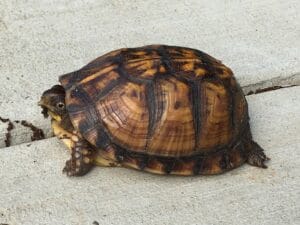Hello, fellow lovers of all things green; I came across two snapping turtles swimming near shore at Catfish Pond in Blairstown, NJ. Turtles have always fascinated me, but more so since my soulful twin brother passed away. Bill felt a strong connection to turtles, marveling over their slow and steady behavior and reverence in many cultures dating back centuries. An old friend from elementary school, whom I recently reconnected with, reflected on the snapping turtles in their Exton PA pond where she grew up. She referenced the creation myths of Native American tribes that named North America “Turtle Island.”
The Story of Turtle Island
According to legend, Earth began on the backside of a turtle, though the tale has many versions, depending on the tribe’s origin.
The Wyandot legend describes the world was once in two parts – animals lived in the lower part covered in water. The Sky World above was where the glorious mountains and valleys were. And where the Sky People lived. A girl from the Sky World fell through a crack into the world below after the ground terrifyingly rumbled. Luckily two swans caught her and took her to Big Turtle, the patriarch of the water, who advised her how to create a world for the child. He said there is soil deep below the ocean.
A muskrat, a beaver, and an otter came forward, bantering about who was best suited for the task. A tiny toad came along, too, and was pooed-pooed for being too small and ugly to help. (Sad that even in folklore, there was bullying.) Big Turtle quieted the crowd, commanding, “Everyone is equal, and everyone will have a chance to try.”
As you likely predicted, the others failed miserably, but the little toad succeeded, bringing back a few grains of soil that grew to be our Earth. Hence, the name Turtle Island and why turtles remain a symbol of the Earth with associations of long life and family.
Turtles are welcome garden guests.
Box turtles, the most common here in New Jersey, are welcome guests in the garden. They eat berries, moss, fungi, and insects, including slugs, one of their favorites. Toads and frogs are welcome, too, each eating up to 10,000 slugs a season and other pests, including grubs.
To attract welcome guests, provide plenty of leaf litter for moist hiding spots, and a dish of water can do if a pond or bog isn’t nearby. The most critical thing is to avoid synthetic herbicides and insecticides as they are particularly devastated by them. With organic practices, healthy turtles, frogs, and toads will be garden helpers keeping pests under control. We sure could use more happy endings.
Garden Dilemmas? AskMaryStone@gmail.com (and now on your favorite Podcast App.)
There’s more to the story in the Garden Dilemmas Podcast:
Related You’ll Enjoy:
There are Natural Slug Remedies beyond inviting a turtle into your garden. Some will surely bring a chuckle.
Saving Snapping Turtles Lifts Spirits – Blog Post
Ep 129. Saving Snapping Turtles Lifts Spirits
Link to The Library of Congress Exhibitions – Exploring the Early Americas: Heavens and Earth



